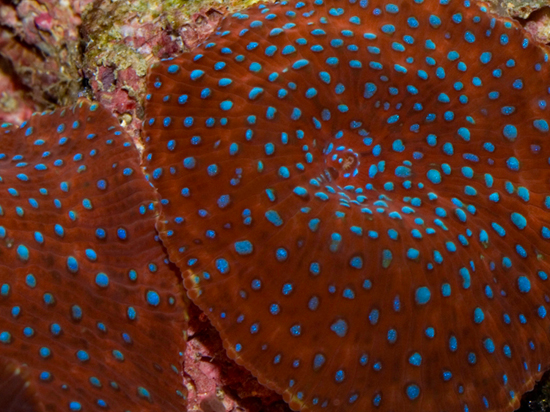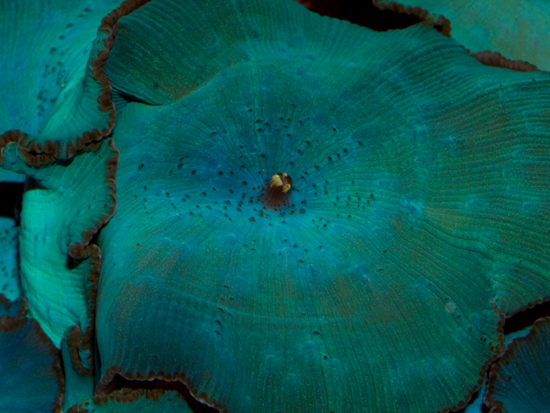“Discosoma: The Tank” @ Sweat Records

Sweat Records, Miami’s best independent music store, asked us to install an aquarium in their new location back in the middle of November. The new store opened on November 31st, so we were hard-pressed for time to develop an idea and build an interesting aquarium. We decided to work with the new Red Sea Max aquarium. The Red Sea Max (RSM) is a self-contained 34-gallon aquarium designed specifically for reef keeping. We had no previous experience with the RSM, but based on the built-in features and modern design, we felt it would provide us with the best platform upon which to proceed. After 2 months, we have a more experienced view of the RSM, and overall the benefits seem to outweigh any shortcomings that we’ve identified.
For a more comprehensive review of our experience with the Red Sea Max, click here…




More than just making thematic sense, we chose Discosoma spp. corallimorphs based on their ease of maintenance, tolerance to fluctuations in water chemistry, and prolific nature. These corallimorphs have done spectacularly well in this aquarium. Already in less than two months, a conservative estimate of population growth of these anthozoans would be at least 30%. The majority of these new polyps are the result of pedal-laceration. Pedal-laceration results when the “mother” polyp extends a piece of flesh off of it’s foot until eventually the flesh detaches and then re-organizes itself into a new polyp near by on the same rock. It is this form of reproductive mechanism that can result in a huge colony of identical clones that dominate a piece of underwater real-estate in the wild.



In addition to Discosoma spp., we also chose to add white pulsing xenia (Xenia umbellata) as the only other species of anthozoan to the tank. We felt that the white color would provide a pleasing contrast to the fluorescence of the corallimorphs. Furthermore, the pulsing abilities of the xenia are certain to entrance casual observers, and add necessary movement to a tank lacking in a large fish population. We started with two small aquacultured colonies, but already less than two months later, several more daughter colonies have established themselves. Ideally, the xenia will continue to spread throughout the live rock.

Motile Invertebrates:
As mentioned previously, all the motile invertebrates added to this tank are local Floridian species, collected by Coral Morphologic.
For scavenging duties we introduced about 20 blue leg hermit crabs (Clibanarius tricolor). These guys provide the tank watcher with never ending amusement as they often wrestle with each other over each other’s shells. It always amuses me when I see a hermit in a bigger shell decided that he wants a smaller hermit’s shell, only to win the battle, pull the loser from his home and quickly realize that he made a serious mistake. Then he has to wrestle all over again to get his old shell back again. However, to keep the peace, we made sure to provide another 20 empty Astrea sp. snail shells. We hide these empty shells inside the interior of the live rock “pyramid”, so they wouldn’t look unsightly.
One polkadot hermit crab (Phimochirus operculatus) was added as an interesting alternative to the blue leg hermits. The polkadotted hermit is fairly aggressive to members of it’s own species, and thus it is important to keep only one in a tank of the RSM’s size. These hermits are one of the fastest moving hermit crabs I’ve encountered; they literally run from one place to another. However, they also tend to be much more cryptic than the blue legs hermits, and therefore it likes to spend much of it’s time inside the protected cavity of the rocks.
We also introduced about 15 small-medium Astrea tecta snails for algae eating duties. These guys are also a delight to casual observers when they are scraping algae from the front panes of the glass, such that you can see their rasping mouth parts in action. They also leave geometrically interesting patterns behind in their “trails” where they have less than efficiently removed algae from the glass.
We added one peppermint shrimp (Lysmata wurdemanni) to control any possible Aiptasia sp. anemones that might have hitched a ride in on the live rock. We knew that there was one or two anemones initially, but we have seen no sign of them since, so it seems that this shrimp has served its duties nicely. This shrimp is very cryptic, rarely venturing out into the open, and lives inside the hollow interior of the “pyramid”.
Two Mithraculus spp. crabs were added to the tank to help control algae, specificaly bubble algae (Valonia spp.). One emerald green crab (Mithraculus sculptus) and one red emerald crab (Mithraculus forceps) were added in order to differentiate the two crabs from each other, so more of an identity could be made by casual observers of the tank. Otherwise both crabs perform almost identical janitorial duties.
We also added two small “harlequin” serpent stars ( Ophioderma appressum). They are popularly known as “harlequin” serpents due to their striking black and white zebra pattern. For the most part they stay hidden away in the inside of the live rock pile, save perhaps an arm or two that extends outward. These serpents seem to have their own “homes” in the rock where they are reliably found day after day.
The most interesting motile invertebrates in the tank are two porcelain crabs (Petrolisthes galathinus). They also seem to have preferred areas in the tank where they are reliably found. These locations seem to be determined by the currents in the tank. These crabs are so fascinating to watch because they have specialized “plankton nets” that they employ to sweep the water for floating food particles. In the wild they seem to be colonial, living in aggregations underneath rocks and coral heads. They can move incredibly swiftly to elude predators. However, if they are cornered, their front claws are very sensitive, and designed to break off easily. Once it falls off, the claw will continue to jerk around and snap open and closed (akin to a gecko dropping it’s tail), presumably to distract the predator from further trying to pursue the crab. Porcelain crabs will quickly regrow these lost claws. We highly recommend these Caribbean porcelain crabs to anyone with a reef tank, especially nano tanks. Beware that many of their Pacific counterparts are commensal with carpet anemones, and thus don’t usually fare well in captivity if they aren’t provided with a suitable host.

One small Floridian sea cucumber (Holothuria floridana) was added to sift through the substrate and digest organic detritus. For the most part it stays hidden in the dark spaces under the rock, but it likely comes out at night to feed. I feel that these cucumbers are some of the best sand sifting organisms a reef keeper can add to his/her tank. It is probably one of the only animals on the planet that has “cleaner” poop from what it eats. Essentially, it uses it’s suction tube feet to feed itself grains of sand and organic detritus. Biological films are removed off the sand grains, and the organic detritus is digested. Only inorganic sand is expelled from the cuke’s backside. Beneficial meiofauna (animals that live in the sand; e.g. bristleworms, amphipods, etc.), are avoided, unlike “sand sifting sea stars”, that can quickly deplete a reef tank of these beneficial sand dwelling critters.
In addition to these specifically added invertebrates, this tank has produced an impressive population of small bristleworms of the genus (Eurythoe sp.). Too often it seems that people feel necessary to pull ones hair out when a few small bristleworms are found in a reef aquarium. Next thing you know they are adding one type of “bristleworm predator” after another in an effort to eradicate any trace of them. Eurythoe sp. bristleworms are essentially detritivores, and I have yet to observe them doing any damage to any of the ornamental organisms in this tank. Their small size allows them to clean detritus from small cracks and crevices in the rock where other detritivores cannot. Larger bristleworms, or fireworms, (Hermodice spp.) are indeed dangerous predators of corals and other ornamental animals, and should be removed as soon as possible.
Fish: Initially we introduced two ORA captive-raised Ocellaris Clownfish (Amphiprion ocellaris); one slightly smaller than the other to encourage the larger one to turn into a female. However, the larger clownfish somehow contracted a fungal disease after about 3 weeks in the tank and subsequently died. The smaller one had a light case of this infection but managed to overcome it and is now doing fine. We will most likely introduce a new captive-raised clownfish in the near future to form a mated pair.
We intend to add a couple more fish in the future, but for the most part we want the focus of the tank to be on the anthozoans and motile invertebrates.
We’ll keep you updated on the progress of this tank as time marches on.
